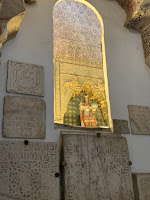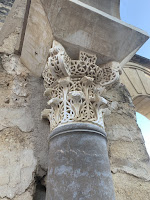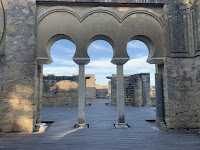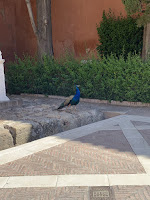5/20/2019
Hoy hicimos un recorrido por la mezquita-catedral de Córdoba, el monumento más importante de todo el mundo islámico occidental y uno de los más increíbles del mundo. Comenzó a construirse en el año 786. La evolución del estilo Omeya en España se encuentra en la historia de la Meaquita, así como en la arquitectura gótica, renacentista y barroca de la arquitectura cristiana. La mezquita-catedral fue construida con materiales reciclados como las columnas romanas con la elección de capiteles. No todas las columnas tienen la misma longitud, algunas de ellas una base, por lo que se agregó un arco doble en la parte superior para agregar la altura, de modo que todas pudieran tener la misma longitud. Algunas columnas ya estaban en estructura gótica, otras fueron enviadas desde varias regiones de Iberia. En total hay 856 columnas de jaspe, ónix, granito de mármol y pórfido. Una de sus principales características es que la mezquita se enfrente a Meca, que es conocido como la tierra sagrada para los musulmanes. También hay una característica única dentro la Mezquita, hay una catedral cristiana dentro de la Mezquita. La catedral se enfrente a Jerusalén, la tierra sagrada para los católicos.
Today we took a tour of the mosque-cathedral of Cordoba, the most important monument of all Western Islamic world and one of the most amazing in the world. It began to be built in the year 786. The evolution of the Omeya style in Spain is in the history of the Mosque, as well as Gothic, Renaissance and Baroque of the Christian architecture. The mosque-cathedral was built with recycled materials such as the Roman columns with choice of capitals. Not all of the columns are the same length, some a base. so a double arch was added to the top to add height so they could all be the same length. Some columns were already in Gothic structure, others were sent from various regions of Iberia. In total there are 856 columns of jasper, onyx, marble granite and porphyry. One of its main characteristics is that the Mosque faces Meca, which is known as the holy ground for Muslims. There is also a unique feature inside the Mosque, there is a Christian Cathedral inside the Mosque. The Cathedral faces Jerusalem, the holy ground for Catholics.
ESU Spain Study Abroad Summer 2019
Thursday, June 13, 2019
La Mendina Azahara
5/22/2019
Hoy fuimos a La Medina Azahara, que se encuentra en las afueras del oeste de Córdoba, España. El palacio de La Medina Azahara fue el hogar del califa Abd-ar-Raham III, el primer califa de los Omeyas de Còrdoba. Fue construido en 936 y se terminò en 940. Lo que le da a la cuidad su aspecto rico es el violeta y el mármol rojo, así como las piedras de oro. La cuidad floreciò durante aproximadamente 80 años antes de ser destruida en 1010 durante la guerra civil. Desde el palacio, el califa tenía una vista de toda la cuidad, en mi opiniòn es una de las vistas más hermosas de Còrdoba. El objetivo principal de la construcción de La Medina Azahara are la dignidad del califa que requería el establecimiento de una nueva cuidad, un símbolo de su poder. En 2018, el sitio fue catalogado como Patrimonio de la Humanidad por la UNESCO con el nombre de inscripción “Cuidad Califal de Medina Azahara”.
Today we we went to La Medina Azahara, which is located on the western outskirts of Cordoba, Spain. La Medina Azahara palace was home to the Caliph Abd-ar-Raham III, the first Umayyad Caliph of Cordoba. It was built in 936 and was finished by 940. What gives the city its rich look is violet and red marble as well as gold stones.The city flourished for approximately 80 years before being destroyed in 1010 during the civil war. From the palace the Caliph had a view of the entire city, in my opinion it is one of the most beautiful views in Cordoba. The main purpose for the construction of La Medina Azahara was the dignity of the Caliph required the establishment of a new city, a symbol of his power. In 2018 the site was listed as a UNESCO World Heritage site with the inscription name "Caliphate City of Medina Azahara".



Priego
5/30/2019
Today we hiked through the Sierra Priego and then after we took a trip to the town of Priego. We walked through the town and visited the Castillo de Priego, the romantic garden and the Municipo de Priego de Cordoba.

The Castillo de Priego is the oldest building in Priego. It was rebuilt in the 13th and 14th centuries. The building has an Arabic style to it. Today there is still as tone wall standing in the castle and has Roman carvings on it. The wall was built from three different stones, one being the oldest stone in Priego.


The garden "Huerta de las Infantas", also known as the romantic garden, dates from the 16th century and it located on the edge of the nautral wall "El Adarve". The wall in the garden protects it from invaders and in holes under the wall were used to preserve food. In the garden there were cherry trees and apricot trees that we got to eat from.






Hoy caminamos por la Sierra Priego y luego después de un viaje al pueblo de Priego. Caminamos por el pueblo y vimos el Castillo de Priego, el jardín romántico y algunas fuentes.
Today we hiked through the Sierra Priego and then after we took a trip to the town of Priego. We walked through the town and visited the Castillo de Priego, the romantic garden and the Municipo de Priego de Cordoba.

The Castillo de Priego is the oldest building in Priego. It was rebuilt in the 13th and 14th centuries. The building has an Arabic style to it. Today there is still as tone wall standing in the castle and has Roman carvings on it. The wall was built from three different stones, one being the oldest stone in Priego.


The garden "Huerta de las Infantas", also known as the romantic garden, dates from the 16th century and it located on the edge of the nautral wall "El Adarve". The wall in the garden protects it from invaders and in holes under the wall were used to preserve food. In the garden there were cherry trees and apricot trees that we got to eat from.




In the Municipo de Priego de Cordoba, we saw the Kings fountain, called Fuente del Rey, and Fuente de la Salud. Fuente del Rey is made up of three pools with 139 spouts. In the first pool there's a lion, which is attritbuted to Alvarez Cubero. The second is presided over by Neptune and Anfotrite. La Fuente de la Salud has a wide mannerist frontispice and the water in the pool is natural and comes from under the ground. Both have been declared National Monuments.


Sunday, June 9, 2019
Sevilla
5/18/2019
Hoy fuimos a Sevilla, España y fuimos guiados por la cuidad por nuestro guía Juan.
Today we went to Seville, Spain and were guided through the city by our tour guide Juan.
Cuando llegamos nos encontramos con nuestro guía de turismo frente al Gaudalquivir, el río que dio origien el arte. Es el quinto río más largo de la Península Ibérica y el segundo río mas largo con toda su longitud en España. También vimos al Torre del Orro que es un monumento nacional justo al lado del puente. La Torre del Orro es una torre de vigilancia militar dodecagonal en Sevilla. Su propósito era proteger a Sevilla y evitar que los cristianos la atacaran desde el río.
When we arrived we met with our tour guide in front of the Gaudalquivir, the river that gave birth to art. It is the fifth longest river in the Iberian Peninsula and the second longest river with its entire length in Spain. We also saw the Torre del Orro, also known as the gold tower, which is national monument right next to the bridge. The Torre del Orro is a dodecagonal military military watch tower in Seville. Its purpose was to protect Seville and prevent the Christians from attacking it from the river.


Luego caminamos hacia la Catedral de Santa María de la Sede de Sevilla, una catedral católica romana en Sevilla. La catedral es la tercera más grande del mundo y es la catedral gótica más grande de todas. Fue construido entre 1434 y 1517. Dentro de la catedral tiene una arquitectura gótica oscura e iconigrafía bíblica. Lo más singular de esta catedral es que es la tumba de Cristóbal Colón.
We then walked walked to the La Catedral de Santa Maria de la Sede de Sevilla, a Roman Catholic Cathedral in Seville also known as The Cathedral of Saint Mary of the See.The cathedral is the third largest in the world and the largest Gothic cathedral of all. It was built between 1434 and 1517. Inside the cathedral it has a dark Gothic architecture and biblical iconography. The most unique thing about the cathedral is it is the tomb of Christopher Columbus.


Incluso tuvimos la oportunidad de escalar la Torre Giralda de la catedral. La torre tiene una rampa con 35 segmentos y una escalera final con 17 escalones que conducen a las campanas.
The last place we saw was the King's Palace, Royal Alcázar de Seville. It has more than 100 years of history to it and was built for the Christian king Peter of Castile. He decided to incorporate Muslim architecture in the palace when it was built because he liked it very much. Today, it is the oldest royal palace still in use in Europe.The upper levels are still used by the royal family as their official residence in Seville. The oldest part of the palace are its walls. Some interesting facts about the palace are that there are six peacocks living around the palace and a scene from Game of Thrones was actually shot here.
Hoy fuimos a Sevilla, España y fuimos guiados por la cuidad por nuestro guía Juan.
Today we went to Seville, Spain and were guided through the city by our tour guide Juan.
Cuando llegamos nos encontramos con nuestro guía de turismo frente al Gaudalquivir, el río que dio origien el arte. Es el quinto río más largo de la Península Ibérica y el segundo río mas largo con toda su longitud en España. También vimos al Torre del Orro que es un monumento nacional justo al lado del puente. La Torre del Orro es una torre de vigilancia militar dodecagonal en Sevilla. Su propósito era proteger a Sevilla y evitar que los cristianos la atacaran desde el río.
When we arrived we met with our tour guide in front of the Gaudalquivir, the river that gave birth to art. It is the fifth longest river in the Iberian Peninsula and the second longest river with its entire length in Spain. We also saw the Torre del Orro, also known as the gold tower, which is national monument right next to the bridge. The Torre del Orro is a dodecagonal military military watch tower in Seville. Its purpose was to protect Seville and prevent the Christians from attacking it from the river.


Luego caminamos hacia la Catedral de Santa María de la Sede de Sevilla, una catedral católica romana en Sevilla. La catedral es la tercera más grande del mundo y es la catedral gótica más grande de todas. Fue construido entre 1434 y 1517. Dentro de la catedral tiene una arquitectura gótica oscura e iconigrafía bíblica. Lo más singular de esta catedral es que es la tumba de Cristóbal Colón.
We then walked walked to the La Catedral de Santa Maria de la Sede de Sevilla, a Roman Catholic Cathedral in Seville also known as The Cathedral of Saint Mary of the See.The cathedral is the third largest in the world and the largest Gothic cathedral of all. It was built between 1434 and 1517. Inside the cathedral it has a dark Gothic architecture and biblical iconography. The most unique thing about the cathedral is it is the tomb of Christopher Columbus.


Incluso tuvimos la oportunidad de escalar la Torre Giralda de la catedral. La torre tiene una rampa con 35 segmentos y una escalera final con 17 escalones que conducen a las campanas.
We even had the opportunity to climb the Giralda Tower of the cathedral. The tower has a ramp with 35 segments and a final stair way with 17 steps leading up to the bells.




El ùltimo lugar que vimos fue el Palacio del Rey, el Real Alcázar de Sevilla. Tiene más de 100 años de historia y fue construido para el rey cristiano Pedro de Castilla. Decidió incorporar la arquitectura musulmana en el palacio cuando se construyó porque le gustó mucho. Hoy en día, es el palacio real más antiguo todavía en uso en Europa. Los niveles superiores todavía son utilizados por la familia real como su residencia oficial en Sevilla. La parte más antigua del palacio son sus murallas. Algunos datos interesantes sobre el palacio son que hay seis pavos reales que viven alrededor del palacio y una escena de Juego de Tronos en realidad fue filmada aquí.
The last place we saw was the King's Palace, Royal Alcázar de Seville. It has more than 100 years of history to it and was built for the Christian king Peter of Castile. He decided to incorporate Muslim architecture in the palace when it was built because he liked it very much. Today, it is the oldest royal palace still in use in Europe.The upper levels are still used by the royal family as their official residence in Seville. The oldest part of the palace are its walls. Some interesting facts about the palace are that there are six peacocks living around the palace and a scene from Game of Thrones was actually shot here.
Subscribe to:
Posts (Atom)















































